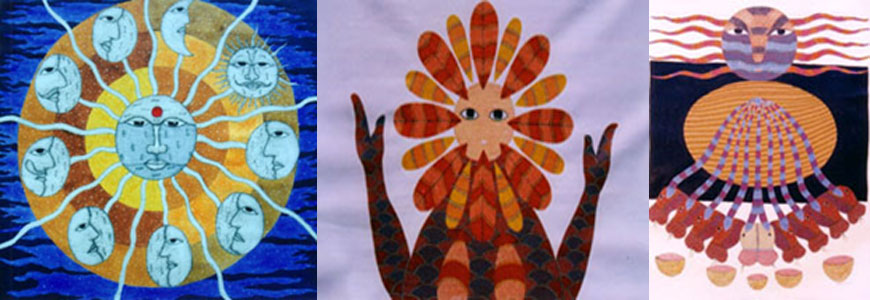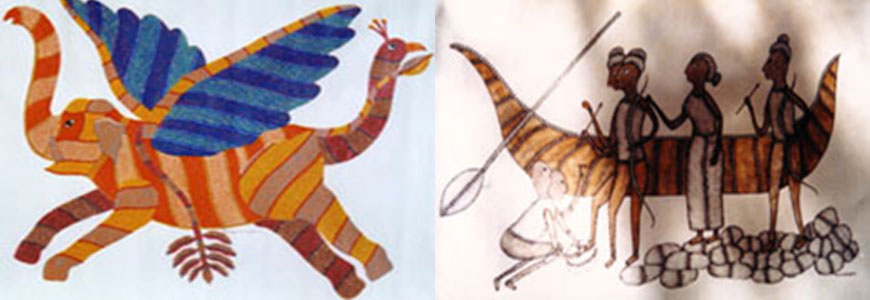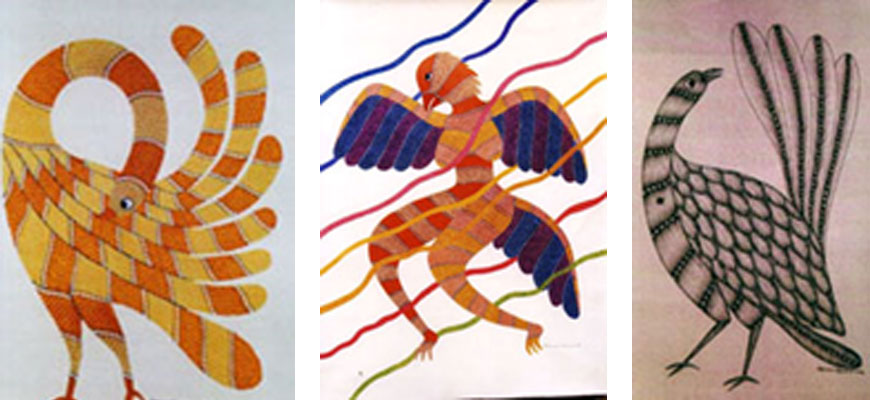Gond people are spread widely across central India. Gondwana or “land of the Gonds”, is an area of southeastern Madhya Pradesh, eastern Maharashtra, and parts of Chhattisgarh, Orissa, and northern Andhra Pradesh. The region was home to several Gond kingdoms from the 15th century to the mid-18th century. Most of the Gonds live in a Village with a Headman known as Mahji or Patel Gonds are divided into different castes called Ahir (Cowherds), Agaria (Blacksmith), Dhuli (Drummers) and Pardhan (bard and singers).
The Gonds have several branches, each with its own story of origin. The Pardhans, they say are descended from the youngest of seven Gond brothers who became a priest and a storyteller on the instruction of Badadev. The Pardhans today are entrusted with keeping the cultural tradition alive through their stories.

Gonds are traditionally agriculturalists and some practice shifting cultivation even today. Other major activities of Gonds include collecting forest produce, fishing, hunting, forging metal goods in cottage industries and other primary sector activities. Gonds are organically connected with nature. They also have a special skill that has been passed down every generation and that is the secrets of the medicine plants. They still follow the traditional system of medicines and use plants and herbs for curing various ailments.
These tribes of India are highly religious minded. Gonds These tribes worship janani or the mother of creator. Gonds tribe also worship pharsa pen, Mariai- the Goddess of plague and other diseases, and Bhimsen. The Hindu God are also worshiped by Gonds tribes in India. Gonds tribe believe that deities control everything in the World. These tribes of India also worship the God of household, God of fields etc. They habitually pray to the ancestral spirits for guardianship and blessings. Each village of Gonds has Village Guardian and a Village Mother who are worshipped during all regular festivals.
Gonds believe in the supernatural forces. Their protectors are the spirits, the gods and goddesses who keep them from harm. One unique feature of their beliefs is the existence of spirits. Gond tribe believe that most places in the world are inhabited by a spirit.The animist Gond believe that the wood is the dwelling place of the gods and hereditary spirits. Their pantheon represents all the aspects of nature. Badadev, the greatest of all gods, is represented by the saja tree. Thakur Dev is associated with the pakri tree.
The Spirits both good and bad are supposed to be inhabit hills, villages, lakes and rivers Sacrifices are also made to appease a number of deities. Sacrifices are made by the Village Priests – Devari – in most of the festivals. Most aspects of the Gond life are filled with animal sacrifices.
Gond oral narratives – the myths, legends, folklore and songs is a part of their culture. The Gonds express themselves through different forms of dance like the Saila, Rina and Dadariya, which are performed during festivals. Their songs, dance forms, myths and legends, folk tales, customs and rituals reflect a close bond with nature and are all inter-related. The understanding of one leads to an understanding of all the others. For instance, the Karma dance is associated with the god Karma Dev who is represented by the karma tree. Karma that can be performed any time of the year. Most of the Gonds festivals are related to agriculture.

Gond paintings have simplicity innocence and charm. They provide a unique opportunity to see how people living in isolation relate to the world around them – to people, animals, gods, demons and other elements. Gond of Madhya Pradesh use dots extensively on the body of gods, and animals indicating movement and validity. Muria tribes uses dots and snall lines. Sometimes even without a solid line they use small lines to outline the figure to create the sense of vitality and action.
Gond do not draw the boundaries of paintings. They place a dot upwards and downwards and side ways for the final image to appear. These dots whenever required are supplemented with elliptical oval and triangular interceptions. The geometry of the drawing is bold as well as loud. The theme of paintings are drawn from folk tales and Gond mythology. Gond themes were confined to scenes for forest, magic, the world of ghosts and spirits, birds animals, sun, noon, man and woman. Each motig continues to be drawn with dots, trangles and chevrons. The boldness of paintings in term of colours renders them a class apart which are seen in Chitrakar Shyam paintings.


